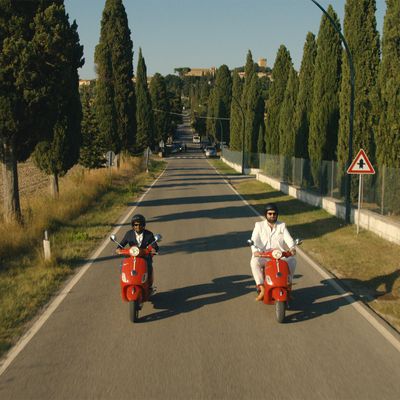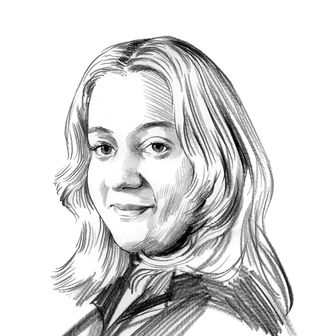
With Master of None’s newest season taking place in both America and Italy, the brain trust behind the musical operation was faced with an unusual task — how would they be able to craft a new sonic world for the time spent in Emilia-Romagna, while also expanding on the signature New York City sound they already established in the first season? For music supervisor Zach Cowie, that meant keeping Master of None’s cross-genre roots firmly in place, but also giving him the freedom to experiment with a few new daring sounds and motifs. (Get ready to hear some funky Italian disco.) Vulture recently called up Cowie to learn everything about creating the show’s soundtrack, from how he chooses the tunes to the way he works with Aziz Ansari.
Woody Allen’s canon helped establish the musical identity of the show.
“Something that Aziz, [co-creator] Alan [Yang], and I talked about going into the first season was that we had a lot of goals based on Woody Allen’s New York movies, like Annie Hall and Manhattan. We started to realize that even though the subject matter of the films is of another time, they’re reinforced with all of these other elements that are timeless. It makes the film live five years, ten years, twenty years after it comes out. I think music is a really good tool for that, to establish this timelessness. If we jam the show full of music from right now, it would seem pretty silly watching it in a few years. It’s not always ‘old’ music, of course. We do have some contemporary stuff in there, but it’s a little less known. This gives us the opportunity to own all of those moments and hopefully bring in an aura of timelessness.”
The show’s primary “New York sound” is all about vintage nightlife music.
“We have a lot of very clear influences for what we call the ‘Master of None New York sound.’ Those really start to show up in this season, especially in the ninth episode where we shoot a big club scene. Aziz and I are big fans of a DJ named Larry Levan, who was a DJ at a club called the Paradise Garage in the late ’70s and early ’80s in New York. And also a DJ named David Mancuso, who was the DJ at a party called the Loft beginning in the early ’70s up until he passed away last year. A lot of our ‘New York sound’ comes from things that would’ve happened in those clubs. That was a decision we all came up with. Woody Allen’s New York is jazz. Louis C.K.’s New York is jazz. What’s our New York? We came up with this Paradise Garage sound. In real life, I’m a DJ, so this is stuff that I know, and those records I know super well. I’m always excited to give a nod to that world. Between those two guys, they invented everything we know about dance culture. It’s important to me to give the nod where it’s due.”
Cowie and Ansari were also conscious to give the soundtrack a genre-bending “cratedigger” influence.
“I’m a massive record nerd. Aziz is getting there. If you go into the new arrivals bin at A1 [Record Shop] in New York, you can imagine making our soundtrack out of what’s in that bin. The stuff people grew up on in New York are still playing in New York, and that cratedigger mentality also lends itself to how unattached to genres or time periods we are. That starts with a reflection of my taste. And in turn, Aziz’s taste. We’re both massive music fans. I come from the record business — that’s what I did before I was a supervisor — for about 20 years. I’m a very curious person, so when I hear something I immediately want to know what came before it and what came after it. The database in my head when I’m doing this job strips away any idea of genre or time period, and I’m really trying to match the feeling with what I’m seeing with the music. The only thing I’m really concerned about is that it moves the story along. I strip all of the tags out of my head that’s like, This is a soul cue, this is a hip-hop cue. I think when you do this long enough, you realize there are really two types of music: good and bad.”
The two opening episodes, set in Italy, have distinctive musical themes.
“Aziz told me right away, I want to do the first episode in black and white and the second episode in color. So we came up with the idea to do the first episode with all repurposed Italian soundtrack music from the ’60s. Everything in that episode is just that. A lot of it is Ennio Morricone, but then the Bicycle Thieves theme is in there as well. That fits into the love letter to Italian cinema. That’s all Italian soundtrack music in the first episode. The way that episode works is that it shouldn’t draw too much attention. Good film-score music is suppose to be a mood enhancer, and that’s what I was trying to do. If people don’t notice it, it means it worked. I’m a massive, massive fan of Morricone. I have tons of his records, so it was a real treat to go through his catalogue and find the right stuff for those moments, which is thousands of songs. For the second episode, since we moved into color, Aziz had the idea to do it all in Italian disco. Him and I love Italian disco records. Everything in the second episode is Italian, although some is sung in English because it was common during the time in that style. We wanted to go into some more vibrant Italian music.”
One particular Italian song was the most sonically important of the season.
“The Italian themes start to come back in nine and ten in a pretty big way. There’s a moment that means a lot to me, it’s probably one of my favorite things I’ve ever been able to do in the show. Right when Aziz told me they were thinking about shooting in Italy, before it even went down, I sent him this song by a guy named Lucio Battisti who I love, called ‘Amarsi Un Po.’ I sent him tons of other stuff eventually down the line, but something about that track really spoke to him when he was working on the ninth episode script. I would get sent stuff as the script was revised, and it was an untitled script for a long time. And then one day it showed up, and it was called ‘Amarsi Un Po.’ So he ended up naming the episode after the song and we closed the episode with it. That was a really big deal to me. But what was even more important was the guy, Lucio Battisti. He was one of the biggest pop singers in Italy in the ’60s and ’70s and ’80s. He really was as popular as the Beatles over there, but his music has never been licensed out of Italy — through the guidance of his manager, it was purposely never taken out of Italy. Our co-supervisor, Kerri Drootin, is my ace detective, and she worked for months to clear that song. We eventually got it, the day before we had to mix the episode. We had an alternate in place, which was fine, but none of us loved it. The whole arc of thinking of that song and then seeing it play such a big part in the season, and then getting the rights to it — I couldn’t have been happier and more proud. It’s a love letter to Italy this season. And to honor it with an artist like him was a really big deal for all of us.”
Cowie sometimes scores a scene without even being given the scripts.
“I can’t give enough credit to Alan and Aziz, who have really great taste and let me try this stuff. A lot of the music comes straight from Aziz, but a ton of it comes from me and him passing stuff back and forth, which we did a lot more in season two. It’s bicoastal. In the entire production, I’m the only one not in New York. I’m in Los Angeles. That made my sleep schedule a little weird for six months. Season one, I came in as stuff was being shot. Season two, since we learned how to collaborate so well in the process of season one, I was actually brought in before a lot of scripts were written for season two, which was a dream come true for me. Him and Alan were just like, Hey dude, we’re gonna do a religion episode, start sending stuff. We had a shared playlist between the three of us, so I would just start feeding music into these playlists based on the themes we were going to cover as it came into my head when they were writing. The playlist was our little idea world. As scripts started to form, I started to see a lot of our ideas baked into them, which was really amazing. There is some stuff that I really can’t work on until I seen it yet, though. In the ninth episode, there’s a scene in the Storm King Art Center, and that was something we knew we couldn’t score until we saw it. The color and the space of that had so much to do with the way it would sound.”


